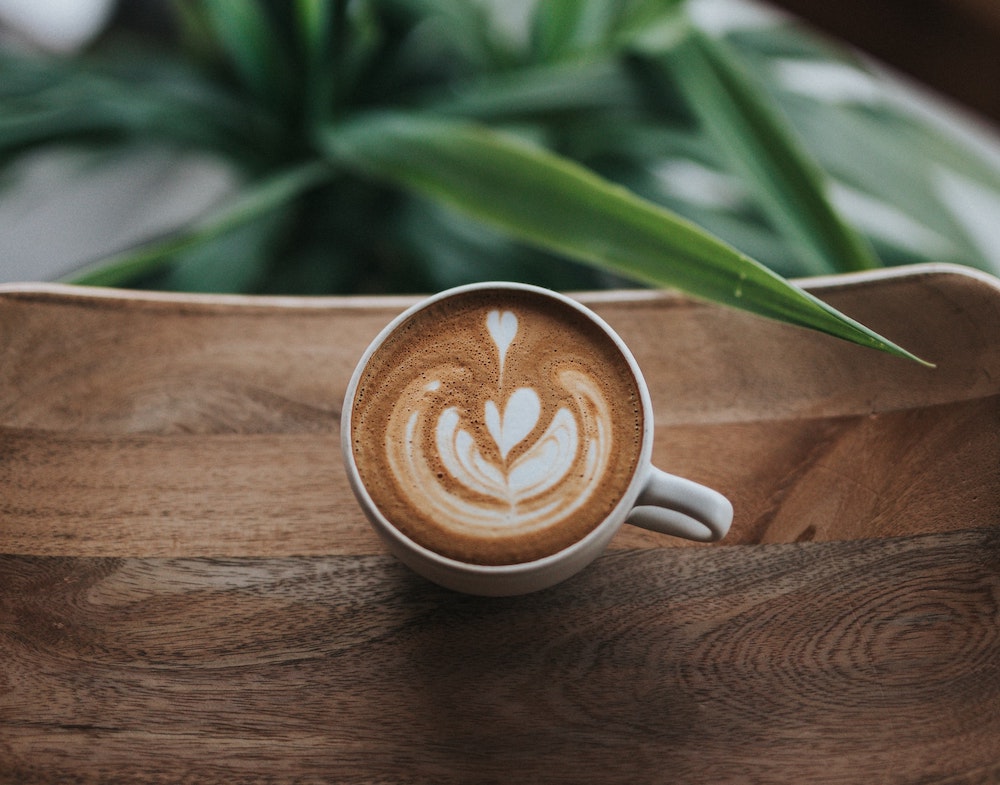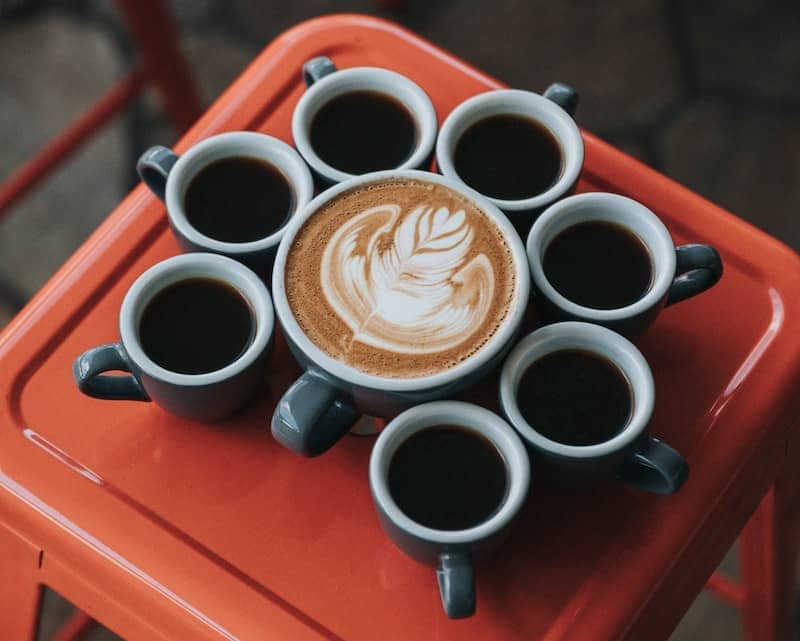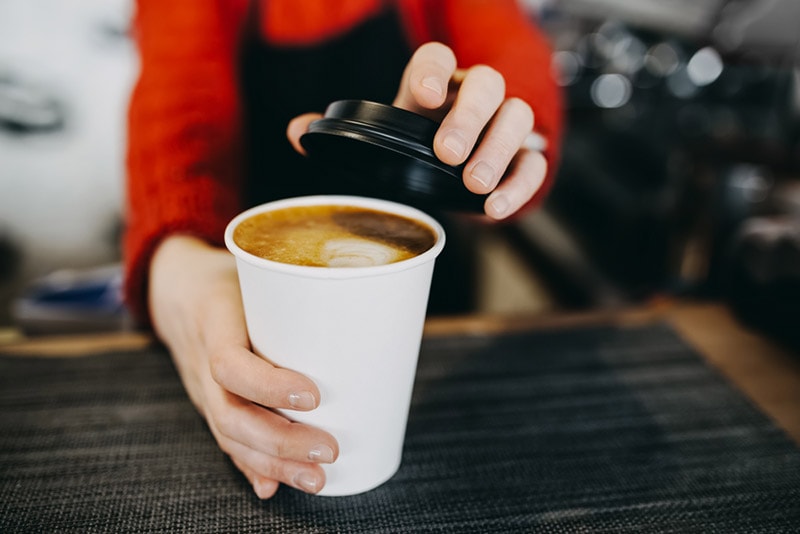
Espresso is a rich, concentrated coffee drink. The standard serving, a shot, is brewed by forcing pressurized hot water through finely-ground coffee beans.
Espresso has a thicker consistency than coffee prepared by other brewing methods. It has a higher concentration of suspended and dissolved solids and crema.
Espresso is also the brewing process used to obtain the espresso drink.

History and Etymology of Espresso
Espresso originates in Italy and the invention of the first espresso machine is attributed to Angelo Moriondo from Turin, Italy, according to the Smithsonian. Moriondo was granted a patent in 1884 for the “instantaneous confection of coffee beverage”. This initial innovation was somewhat lost until 1903 when Luigi Bezzera made a few improvements to the original and invented the single-shot machine that brews directly into the cup.
Interestingly, the espresso machine from the 19th century was an invention to speed up the process of brewing coffee. Today, espresso is a synonym for high-end coffee preparation and is considered by many the best way to prepare coffee.
Espresso was initially called crema caffè, due to the top layer of crema. The term was eventually replaced with espresso. An espresso variant is still called café crema.
It was in 1906, at the Milan Fair, when Luigi Bezerra and Desiderio Pavoni presented their new coffee machine, and they coined the term cafeé espresso.
In a paper from 1919, there is a mention of coffee espresso, which suggests that at the time espresso was widely used.

Spelling – Espresso or Expresso?
There’s some confusion around the correct spelling of the word. The correct spelling is espresso, even though expresso is an accepted variant in English. In coffee circles, the variant spelled with an x is not legitimate.
What Does Espresso Mean?
In Italy, the origin country of espresso, this type of beverage is simply called caffé, as this is the coffee that is ordinarily served in coffee shops.
The Italian word espresso has a few meanings, which makes the name even more interesting. Espresso can be translated as:
- “made to order,” which is how espresso is brewed, one coffee at a time.
- “fast,” which refers to the extraction time, the fastest among all brewing methods
- “pressed,” which is the brewing method used to make an espresso – using pressure

Espresso-Based Beverages

Espresso can be prepared in various sizes and concentrations. A shot can be pulled in three major concentration variants: normale, ristretto, and lungo. The three variants differ by the amount of water used to extract a given coffee quantity and the extraction time.
A shot can be also pulled in various sizes, the most common being double espresso, (doppio). Other variants include single shot, (solo), and triple shot, (triplo).
The espresso shot can be also combined with hot water for a diluted variant. When the hot water is poured on top of the coffee, the beverage is called Americano. When water is poured into the cup, and the shot is pulled over the water, the beverage is called long black.
Milk and Espresso Based Drinks
Apart from being served alone, espresso is frequently blended, particularly with milk. Milk is typically heated and/or textured as follows: steamed milk, (without significant foam), wet foamed milk, (microfoam), or dry foamed, (also called frothed milk), and with hot water.
Then the milk is added to the coffee in various ratios.
Espresso is used for preparing most milk and coffee-based drinks including macchiato, latte, cappuccino, mocha, and flat white. The reason for using espresso is the strong flavor and aroma specific to this coffee.
Although some home baristas use stronger drip coffee as an alternative, the taste is different, and any knowledgeable coffee lover will spot the difference.

Espresso Preparation
The definition of espresso says it is obtained by pushing hot water through a puck of finely ground coffee. This means devices such as the Moka pot, steam espresso machines, can be classified as espresso coffee makers. And indeed many coffee lovers treat them as such.
The reality, however, reveals that the taste and aroma of a shot pulled with a pump-operated espresso machine are very different from other methods. This is because pulling an espresso shot needs a lower water temperature and 9 bar pressure, (9 bar is 8.8823 atmospheres).
While a vast majority of coffee lovers refer to Moka pot and AeroPress coffee as espresso, in the specialty coffee circles these are called espresso alternatives.
The espresso brewing process is one of the most complex of all coffee brewing methods, and it involves more brewing variables to account for than any other preparation method. These variables are Extraction Pressure, Brewing Temperature, Grind Size, and Dose (coffee ratio). All parameters are interdependent; if you change one variable, you might need to change one or more of the other ones too.
Types of Espresso Machines and Espresso Makers

1. Manual Espresso Makers – Lever Operated Machines
Manual espresso machines use human force to create the necessary pressure for brewing. The most common ones are lever-operated through manual pumps, though other systems exist.
Some lever espresso makers have built-in water heaters.
2. Semi-Automatic Espresso Machines
Semi-automatic espresso machines are devices that partially automate the espresso brewing process. The semiautomatic espresso machine will control the brewing temperature and the pressure during the shot extraction.
3. Automatic Espresso Machines
Automatic espresso machines have one or more extra automatization features, such as a built-in timer to stop the shot at 25-30 seconds.

4. Super-Automatic Espresso Machines
The super-automatic espresso machine has all, or almost all aspects of the espresso brewing automated, from weighing the beans to coffee grinding up to milk-steaming.
5. Capsule-Based Espresso Machines
Capsule-based espresso machines use coffee capsules, for preparing espresso. The advantage of this technology is that espresso brewing is standardized, avoiding human error. The disadvantage is that some of the machines prepare milder-tasting espressos. Some of the manufacturers are Lavazza, Nespresso, De’Longhi and iLLY.

What Coffee Beans Are Used for Espresso? What Roast?
Contrary to a popular belief, espresso is not a specific bean or roast. Historically, in North America, the typical espresso blend is roasted very dark. The dark roast has the advantage that gets extracted easier because a darker coffee bean is more soluble.
Although a dark roast facilitates the extraction of coffee oils, coffee experts can modify the extraction variables in such a way that lighter roasts can be used with the same success.
Certain blends or single-origin beans can be more forgiving to the beginner barista. These can yield a high amount of crema, and provide a good taste profile, despite brewing errors.
The roasting process facilitates the release of CO2, and this is another reason for roasting darker for espresso. Concretely, darker roasts contain more CO2 than lighter ones, and in turn, this would yield more crema.
Espresso Grind Size
The grind size for espresso is finer than most other brewing methods, and this is particularly important for the extraction process. The grind size and the dose are what control the shot’s flow, but the grind size is more important out of the two.
Grinding finer, we restrict the flow more, so we need a higher pressure to push the water through the coffee puck.
We cannot use a medium grind, (typical for drip coffee), to pull an espresso shot, because the pressure during extraction would be too low, and the shot would flow too fast.

Crema – The Espresso Coffee Foam
Although the espresso pressure brewing method is over 150 years old, for most of this history, espresso didn’t have crema. Crema wasn’t an espresso feature until 1947 when Achille Gaggia invented the hand-pumped machine. The new machine exerted more pressure over the coffee puck, extracting more oils and colloids, thus creating crema.
Crema is a flavorful, brown froth that rests on top of a shot of espresso. It is formed by emulsifying air bubbles and coffee colloids into coffee’s soluble oils. Some people call this the “Guinness effect” because of the resemblance with the popular Irish stout.
Crema is considered a sign of a properly prepared espresso shot, and the absence of it points to flaws in the brewing process or the quality of the beans.
There is an opinion among coffee connoisseurs that crema is not that important. This opinion goes as far as to suggest that it is better to scrape off the crema from the espresso shot.
Caffeine Content of Espresso
There is a common belief that espresso has more caffeine than drip coffee. This is true if we measure the caffeine content per unit volume. A shot of espresso, has 1 oz volume, about 30 ml, and contains 47 to 64 mg of caffeine. A drip coffee in North America has a standard volume of about 8 oz and contains 95 to 165 mg of caffeine. Most espresso drinkers will buy a doppio, rather than a solo though. With a double espresso, the total caffeine quantity is between 90 and 130 mg.
If we measure the caffeine extracted from the same amount of ground coffee, drip coffee seems to extract more caffeine per gram of ground coffee. We use about 15 grams for a double shot espresso, which will extract 90-130 mg of caffeine. We use about 12 grams of ground coffee for preparing an 8oz cup of coffee, which will extract about 95-170 mg of caffeine. So we get approximately the same amount of caffeine, using a different dose.

Espresso vs Drip Coffee
Espresso is different from drip coffee in a few ways. The use of pressure during brewing changes the way soluble solids and oils are extracted from the coffee beans.
During espresso extraction, aromatic oils in coffee are emulsified into the water, and the soluble solids are extracted very fast.
During drip brewing, or other gravitation, or immersion brewing methods, the extraction is much slower, and there is no pressure. This can result in more bitter compounds being extracted into the final cup. Without pressure, fewer oils will be extracted from the beans, and the extracted oils will not be emulsified, thus there will be no crema.
In espresso, we use a finer grind, which tends to introduce more fines in the final cup. This also contributes to the thickness of the espresso coffee.
Espresso is brewed concentrated, typically, though there are “longer coffee” variants such as cafe crema, or Americano.
Featured image credit: Unsplash















